Partial recovery of senescence and differentiation disturbances in CD8+ T cell effector-memory cells in HIV-1 infection after initiation of anti-retroviral treatment
- PMID: 27377704
- PMCID: PMC5054564
- DOI: 10.1111/cei.12837
Partial recovery of senescence and differentiation disturbances in CD8+ T cell effector-memory cells in HIV-1 infection after initiation of anti-retroviral treatment
Abstract
Immune senescence as well as disturbed CD8+ T cell differentiation are a hallmark of chronic HIV infection. Here, we investigated to what extent immune senescence is reversible after initiation of anti-retroviral treatment (ART). Peripheral blood mononuclear cells (PBMCs) from a cohort of HIV patients with different disease courses, including untreated viral controllers (n = 10), viral non-controllers (n = 16) and patients on ART (n = 20), were analysed and compared to uninfected controls (n = 25) by flow cytometry on bulk and HIV-specific major histocompatibility complex (MHC) class I tetramer+ CD8+ T cells for expression of the memory markers CCR7 and CD45RO, as well as the senescence marker CD57 and the differentiation and survival marker CD127. Furthermore, a subset of patients was analysed longitudinally before and after initiation of ART. Frequencies of CD57+ CD8+ T cells decreased after initiation of ART in central memory (Tcm) but not in effector memory T cell populations (TemRO and TemRA). The frequency of CD127+ CD8+ cells increased in Tcm and TemRO. We observed a reduction of CD127- T cells in Tcm, TemRO and partially in TemRA subsets after initiation of ART. Importantly, HIV-specific CD8+ TemRO cells predominantly displayed a CD127- CD57+ phenotype in untreated HIV-patients, whereas the CD127+ CD57- phenotype was under-represented in these patients. The frequency of the CD127+ CD57- CD8+ T cell subpopulation correlated strongly with absolute CD4+ counts in HIV-infected patients before and after initiation of ART. These findings can be interpreted as a phenotypical correlate of CD8+ memory T cell differentiation and the premature 'ageing' of the immune system, which was even observed in successfully virally suppressed HIV patients.
Keywords: AIDS; T cells; cytotoxic T cells; viral.
© 2016 British Society for Immunology.
Figures
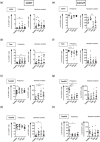
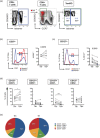
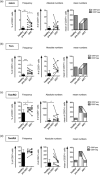
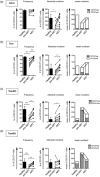
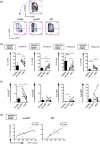
Similar articles
-
Clonal expansion and TCR-independent differentiation shape the HIV-specific CD8+ effector-memory T-cell repertoire in vivo.Blood. 2010 Jul 22;116(3):396-405. doi: 10.1182/blood-2009-11-254136. Epub 2010 Apr 27. Blood. 2010. PMID: 20424187 Free PMC article.
-
HIV-1-infected children on HAART: immunologic features of three different levels of viral suppression.Cytometry B Clin Cytom. 2007 Jan 15;72(1):14-21. doi: 10.1002/cyto.b.20152. Cytometry B Clin Cytom. 2007. PMID: 17041945 Clinical Trial.
-
The proportion of CD57+ cells among effector CD8+ T cells is lower in HIV controllers compared with antiretroviral therapy-treated patients.AIDS. 2019 Nov 15;33(14):2137-2147. doi: 10.1097/QAD.0000000000002342. AIDS. 2019. PMID: 31688039
-
Blocking Formation of the Stable HIV Reservoir: A New Perspective for HIV-1 Cure.Front Immunol. 2019 Aug 22;10:1966. doi: 10.3389/fimmu.2019.01966. eCollection 2019. Front Immunol. 2019. PMID: 31507594 Free PMC article. Review.
-
Elevation and persistence of CD8 T-cells in HIV infection: the Achilles heel in the ART era.J Int AIDS Soc. 2016 Mar 3;19(1):20697. doi: 10.7448/IAS.19.1.20697. eCollection 2016. J Int AIDS Soc. 2016. PMID: 26945343 Free PMC article. Review.
Cited by
-
Tetramer-Based Enrichment of Preexisting Anti-AAV8 CD8+ T Cells in Human Donors Allows the Detection of a TEMRA Subpopulation.Front Immunol. 2020 Jan 21;10:3110. doi: 10.3389/fimmu.2019.03110. eCollection 2019. Front Immunol. 2020. PMID: 32038634 Free PMC article.
-
The role of TEMRA cell-mediated immune senescence in the development and treatment of HIV disease.Front Immunol. 2023 Oct 12;14:1284293. doi: 10.3389/fimmu.2023.1284293. eCollection 2023. Front Immunol. 2023. PMID: 37901239 Free PMC article. Review.
-
Increased CD127+ and decreased CD57+ T cell expression levels in HIV-infected patients on NRTI-sparing regimens.J Transl Med. 2017 Dec 20;15(1):259. doi: 10.1186/s12967-017-1367-5. J Transl Med. 2017. PMID: 29262860 Free PMC article.
References
-
- Strategies for Management of Antiretroviral Therapy Study Group , El‐Sadr WM, Lundgren J. et al CD4+ count‐guided interruption of antiretroviral treatment. N Engl J Med 2006; 355:2283–96. - PubMed
-
- Brenchley JM, Karandikar NJ, Betts MR. et al Expression of CD57 defines replicative senescence and antigen‐induced apoptotic death of CD8+ T cells. Blood 2003; 101:2711–20. - PubMed
-
- Lieberman J, Trimble LA, Friedman RS. et al Expansion of CD57 and CD62L–CD45RA+ CD8 T lymphocytes correlates with reduced viral plasma RNA after primary HIV infection. AIDS 1999; 13:891–9. - PubMed
MeSH terms
Substances
LinkOut - more resources
Full Text Sources
Other Literature Sources
Medical
Research Materials

